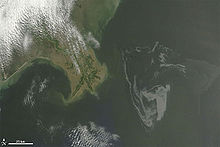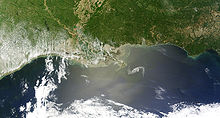- Man-made structures visible from space
-
Man-made structures visible from earth orbit without magnification (by mechanical aids such as a camera or binoculars) include highways, dams, and cities.[1][2][3] The most commonly cited example, the Great Wall of China, is barely visible from low earth orbit (under perfect conditions), but not from the moon.[3][4]
Part of the problem of discerning fact from urban legend is defining how far up "space" is, which could be anywhere from the edge of space at an altitude of 100 kilometers (62 mi); to Apollo 12's orbital at 290 km (180 mi); to the moon, which orbits about 381,415 km (237,000 mi) away.[3] A best estimated definition would be in the hundreds of kilometres into space.[3] Another definition is the Kármán line, which is at the altitude of 100 km (62 mi) above the Earth's sea level. That line is accepted by the Fédération Aéronautique Internationale (FAI), which is an international standard setting and record-keeping body for aeronautics and astronautics, as the boundary between the Earth's atmosphere and outer space.[5]
Cities are easily distinguishable from surrounding countryside by both shuttle astronauts in an Earth orbit 135 miles (217 km) high[1] as from space stations, which orbit much higher, circling the planet at c. 250 miles (400 km). Using binoculars, the astronauts can see roads, airports, dams, harbors, even large vehicles such as ships and planes.[2][6] At an orbit of 160 to 350 miles, many such objects are visible from the Space Station.[3]
Contents
Cities at night
Metropolitan areas are readily visible at night, particularly in industrialized countries, due to a multitude of street lights and other light sources in urban areas (see light pollution).
The Great Wall of China
- Main article: Great Wall of China
The Great Wall of China is, proverbially, the man-made object most often cited as being visible from outer space. Claims are made for the factoid that it is visible from the Moon. William Stukeley mentioned this claim in his letter dated 1754.[7] The claim was mentioned by Henry Norman in 1895 as if it was already well-known.[8] The issue of "canals" on Mars was prominent in the late 19th century and may have led to the belief that long, thin objects were visible from space.[9] The claim the Wall is visible has been debunked many times,[1][2][3] but is still ingrained in popular culture.[10] The viewer would need visual acuity 17,000 times better than normal (20/20) to see the Wall from the Moon, and vision 8 times better than normal to see it from low earth orbit.[11]
Other buildings and constructed objects
"The naked eye can tell the difference between cities and countryside from space." [12]
The "People's House" in Bucharest, Romania is the second largest building in the world, after The Pentagon, and has been cited as being visible from space.[13]
Pollution
 The Deepwater Horizon oil spill oil slick as seen from space by NASA's Terra satellite on May 1, 2010.
The Deepwater Horizon oil spill oil slick as seen from space by NASA's Terra satellite on May 1, 2010.
Large-scale pollution is almost invariably described in terms of visibility from space. The BP Spill or Deepwater Horizon oil spill of April 20, 2010 was so described in news stories,[14] on scientific websites,[15][16] as well as jokes about the spill.[17] Algae blooms and sewage, which are indirectly created by man-made pollution, are visible, and have been photographed, from space.[18][19]
Popular culture
The concept has entered popular culture as a factoid ("the Great Wall of China is the only man-made object visible from the moon"), meme ("Many are familiar with the claim") trivia questions,[2] metaphor, urban legend,[1][3] and proverb, that certain constructed objects or effects are so large as to be visible from outer space. For example, a giant beaver dam in Canada was described as "so large it is visible from outer space."[20] Field and Stream asked and answered, "How big? Big enough to be visible ... from outer space."[21]
Notes
- ^ a b c d Urban Legends.com website. Accessed May 12, 2010.
- ^ a b c d Cecil Adams, Is the Great wall of China the only manmade object you can see from space?", The Straight Dope, found at The Straight Dope website. Accessed May 12, 2010.
- ^ a b c d e f g Snopes, "Great wall from space", last updated 21 July 2007, found at Snopes.com archives. Accessed May 12, 2010.
- ^ "the wall is only visible from low orbit under a specific set of weather and lighting conditions. And many other structures that are less spectacular from an earthly vantage point—desert roads, for example—appear more prominent from an orbital perspective." The Afsluitdijk in The Netherlands can also be seen from outer spaceScientific American found at Is China's Great Wall Visible from Space? at Scientific American website.
- ^ "The 100 km Boundary for Astronautics" (DOC). Fédération Aéronautique Internationale Press Release. 2004-06-24. http://www.fai.org/press_releases/2004/documents/12-04_100km_astronautics.doc. Retrieved 2006-10-30.
- ^ Starry Skies website
- ^ The Family Memoirs of the Rev. William Stukeley (1887) Vol. 3, p. 142. (1754) "Chinese wall, which makes a considerable figure upon the terrestrial globe, and may be discerned at the moon."
- ^ Norman, Henry, The Peoples and Politics of the Far East, p. 215. (1895) "Besides its age it enjoys the reputation of being the only work of human hands on the globe visible from the moon."
- ^ "How is Great Wall of China from Space?"
- ^ "Metro Tescos", The Times (London), April 26, 2010. Found at The Times website. Accessed May 12, 2010.
- ^ Norberto López-Gil. "Is it Really Possible to See the Great Wall of China from Space with a Naked Eye?". Journal of Optometry 1 (1): 3–4. http://www.journalofoptometry.org/Archive/vol1/pdf/02%20Vol1-n1%20Letter%20to%20the%20Editor.pdf.
- ^ Great Wall of China from Outer Space
- ^ "Letter from Bucharest," The New Presence, vol, 1, no. 1, p. 47 (2004); abstract found at CEEOOL.com website. Accessed May 12, 2010.
- ^ Tom Fletcher, BC Local news, May 4, 2010, found at BC Local News website. Accessed May 12, 2010.
- ^ Phil Plait, "Damn." Scientific American Bad Astronomy blog, June 22, 2010. Found at Scientific American's website. Accessed June 23, 2010.
- ^ "On Saturday, June 19, 2010, oil spread northeast from the leaking Deepwater Horizon well in the Gulf of Mexico. The oil appears as a maze of silvery-gray ribbons in this photo-like image from the Moderate Resolution Imaging Spectroradiometer (MODIS) on NASA’s Terra satellite." "Oil Slick in the Gulf of Mexico," Posted June 22, 2010 on NASA website. Found at NASA website. Accessed June 23, 2010.
- ^ "Which is more visible from outer space, the BP spill, or Obama's massive ego?", found at Yahoo Answers. Accessed May 12, 2010.
- ^ "Satellite Images of Marine Phytoplankton Blooms," found at Geology.com. Accessed May 12, 2010.
- ^ "Gaza sewage flood visible from outer space," Ma'an News Agency, found at Ma'an News site. Accessed May 12, 2010.
- ^ Michel Comte and Jacques Lemieu, "World's biggest beaver dam discovered in northern Canada," AFP, May 5, 2010, found at Yahoo News. Accessed May 12, 2010.
- ^ Field notes, "Giant Alberta Beaver Dam Is Visible from Space," found at Field and Stream website. Accessed May 12, 2010.
External links
Categories:- Urban legends
- Orbits
- Great Wall of China
- Megastructures
Wikimedia Foundation. 2010.

